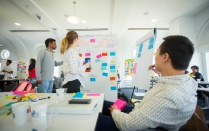Leaving People Behind: How WaSH Practitioners Must Include the Community Perspective in their Planning

NEWAH WASH, Dept of Foreign Affairs and Trade, Jim Holmes, 2013, CC2.0, Modified
By Gauri Desai
Published November 10, 2015 This content is archived.
One billion people around the world have some form of disability, and of these, 360 million do not have access to improved sanitation facilities [1,2].
Vulnerable populations, such as children, pregnant women, adolescent girls, ageing populations and people with disabilities have varying needs with respect to water, sanitation, and hygiene (WASH). Recognizing and incorporating these needs into the design and development of WASH programs is essential to ensure that these people are not marginalized in society. This requires overcoming a multitude of barriers: 1. Environmental barriers such as design and location of latrines, 2. Attitudinal barriers such as negative beliefs about disabilities and 3. Institutional barriers such as non-inclusive policies in society.
In recent years, the WASH sector has paid attention to mainstreaming the needs of women and children to a large extent [3,4]. Schools have been the target of many WASH interventions, and improved WASH programs in schools are associated with better educational outcomes and better health [5-7]. Similarly, efforts have been directed toward incorporating menstrual hygiene management practices in the community led total sanitation (CLTS) programs, with encouraging results [8]. Such programs, however, have not been directed toward women with disabilities. Nevertheless, the lessons learnt from such programs can be used to develop WASH programs for people with disabilities.
The benefits to a participatory approach in WASH for women and in schools are well documented [9-11]. Plan International, a developmental organization used this approach to build girl-friendly latrines in schools in Ghana [10], a Community Led Total Sanitation project in Bangladesh [11], and in building accessible latrines for people with disabilities in Nepal [12]. This approach is useful for addressing the environmental barriers that people with disabilities face while accessing sanitation facilities.
Organizing community level discussions, workshops and events to break the existing myths and taboos about menstruation has been successful in reducing the stigma associated with it [8]. This approach can be applied to reduce the myths and stigma associated with disabilities, and address the attitudinal barriers that people with disabilities face.
In the early 1990s, WASH programs in schools focused on construction of sanitation facilities. Over the years, the need to combine such design-based solutions with education-based solutions has become clear. WASH programs in schools now also focus on capacity building, education and awareness programs, and the integral participation of teachers, parents, and community members [10]. WASH programs may better address the problem of sanitation for people with disabilities by incorporating this approach.
References
- WHO, World report on disability. 2011.
- WHO, WHO Director-General Dr. Margaret Chan's message on the International Day of Persons with Disabilities 2014. 2014.
- Fisher, J., Women in water supply, sanitation and hygiene programmes. 2008.
- Zomerplaag, J., A. Mooijman, and UNICEF, Child-friendly hygiene and sanitation facilities in schools: indispensable to effective hygiene education, in Child-Friendly hygiene and sanitation facilities in schools: indispensable to effective hygiene education. 2005, IRC.
- Birdthistle, I., et al., What impact does the provision of separate toilets for girls at schools have on their primary and secondary school enrolment, attendance and completion?: A systematic review of the evidence. 2011: EPPI-Centre, Social Science Research Unit, Institute of Education, University of London London, UK.
- Bowen, A., et al., A cluster-randomized controlled trial evaluating the effect of a handwashing-promotion program in Chinese primary schools. The American journal of tropical medicine and hygiene, 2007. 76(6): p. 1166-1173.
- Freeman, M.C., et al., Assessing the impact of a school‐based water treatment, hygiene and sanitation programme on pupil absence in Nyanza Province, Kenya: a cluster‐randomized trial. Tropical Medicine & International Health, 2012. 17(3): p. 380-391.
- Cavill, S., Frontiers of CLTS: Innovations and Insights.
- Ahmed, R. and K. Yesmin, Menstrual hygiene: breaking the silence. Beyond Construction: Use by A ll, a Collection of Case Studies from Sanitation and Hygiene Promotion Practitioners in South Asia, 2008: p. 283-287.
- IRC, Girl friendly toilets for Schoolgirls. 2006, Water and Sanitation Centre (2006)
- Kar, K., Subsidy or self-respect?: participatory total community sanitation in Bangladesh. 2003.
- Pradhan, A. and O. Jones, Creating user-friendly water and sanitation services for the disabled: The experience of WaterAid Nepal and its partners. Construction, 2008.
